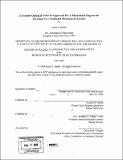A pseudo-optimal control approach for a redundant degree-of-freedom in a gimbaled mechanical system
Author(s)
Smith, Jason T. (Jason Thomas), 1978-
DownloadFull printable version (6.037Mb)
Other Contributors
Massachusetts Institute of Technology. Dept. of Aeronautics and Astronautics.
Advisor
Russell D. Smith.
Terms of use
Metadata
Show full item recordAbstract
Unaided inertial navigation systems of sufficient quality allow a missile or other body to navigate freely for potentially long periods of time. The use of four gimbals in such systems allows for elimination of large platform excursions while avoiding the uncontrollable condition of gimbal lock. The thesis investigates the benefits of applying a Linear Quadratic Regulator (LQR) to the control of the redundant degree-of-freedom present in a four gimbal inertial navigation system. Equations of motion for a four gimbal system are defined and linearized. A benchmark controller is developed, using classical time and frequency domain techniques, for comparison with the LQR controller. The quadratic weightings for the LQR controller are investigated using principles of loop shaping. Due to the time-varying nature of the linearized gimbal system, optimal gains are calculated for a variety of nominal conditions and stored in a look-up table. The classical and LQR controllers, as well as models of the four gimbal system components and sensors, are evaluated strictly via simulation. Metrics for determining controller performance are defined and a search is made for worst-case initial conditions and disturbances. A comparison with the benchmark controller at these worst-case conditions is made. It is found that the LQR control technique is of significant benefit when applied to the redundant degree-of-freedom. In particular, several of the metrics show significant improvement and others show marginal improvement. Also, the LQR controller makes more complete use of the available torque capacity, improving the performance of the four gimbal system. Ideas for future areas of investigation are presented.
Description
Thesis (S.M.)--Massachusetts Institute of Technology, Dept. of Aeronautics and Astronautics, 2004. Includes bibliographical references (p. 185-186).
Date issued
2004Department
Massachusetts Institute of Technology. Department of Aeronautics and AstronauticsPublisher
Massachusetts Institute of Technology
Keywords
Aeronautics and Astronautics.